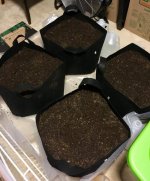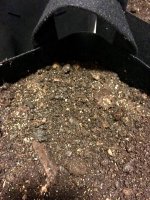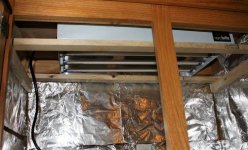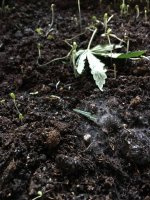Large chunks of oyster shell could be a areation source with long term Ca slowly becoming available. But not the same as powdered. It's all about surface area.
Aragonite is expensive and only comes from one or two places. Hi calcium lime is cheap cheap cheap. Depends on the cost for a small amount you need.
If you don't add castings dont sweat it. Just make sure you use the highest quality humus source you can find, weither it be castings or compost.
Always add worms. Nothing better in a no till situation. I notice plants do not get root bound with worms. My little 4" pots all have worms and the never get root bound. As long as you provide nutrition in a topdressing the worms will eat old roots and the top-dress to feed the plant. Then the old roots just get turned into castings.
Worms are the backbone of my notill/recycled experience.
As bigdaddy pointed out constant watering is key. You want them to be wet all the time. If 1 is bone dry and 10 will not hold any more water, you want to bounce between a 4 and 8.
As bigdaddy has noticed your nitrogen cycle and microbes take a hit drying out and it take time for them to get going again.
Never never never let them dry out.
Biochar is a specially made charcoal (not to be confused with the cooking charcoal) that increases the nutrient storing compasity and creates homes for microbes.
It should never be used raw. First you should charge it by either soaking it in a bucket with fish hydrolyze or something similar or mixing with you compost for a week before you make your mix.
Biochar is so absorbent that if added raw it will soak up all the notes in your soil and kill hour plants.
Biochar is not needed, and if you add it only use at 10% of your total mix.
I would mix a extra 10 gals. You will need some extra for clones/little ladies and smaller pots.
Oh and ALWAYS use a thick mulch. It will feed the worms and help keep the soil.moist. another valuable tool in notill/recycled gardening.
Aragonite is expensive and only comes from one or two places. Hi calcium lime is cheap cheap cheap. Depends on the cost for a small amount you need.
If you don't add castings dont sweat it. Just make sure you use the highest quality humus source you can find, weither it be castings or compost.
Always add worms. Nothing better in a no till situation. I notice plants do not get root bound with worms. My little 4" pots all have worms and the never get root bound. As long as you provide nutrition in a topdressing the worms will eat old roots and the top-dress to feed the plant. Then the old roots just get turned into castings.
Worms are the backbone of my notill/recycled experience.
As bigdaddy pointed out constant watering is key. You want them to be wet all the time. If 1 is bone dry and 10 will not hold any more water, you want to bounce between a 4 and 8.
As bigdaddy has noticed your nitrogen cycle and microbes take a hit drying out and it take time for them to get going again.
Never never never let them dry out.
Biochar is a specially made charcoal (not to be confused with the cooking charcoal) that increases the nutrient storing compasity and creates homes for microbes.
It should never be used raw. First you should charge it by either soaking it in a bucket with fish hydrolyze or something similar or mixing with you compost for a week before you make your mix.
Biochar is so absorbent that if added raw it will soak up all the notes in your soil and kill hour plants.
Biochar is not needed, and if you add it only use at 10% of your total mix.
I would mix a extra 10 gals. You will need some extra for clones/little ladies and smaller pots.
Oh and ALWAYS use a thick mulch. It will feed the worms and help keep the soil.moist. another valuable tool in notill/recycled gardening.








